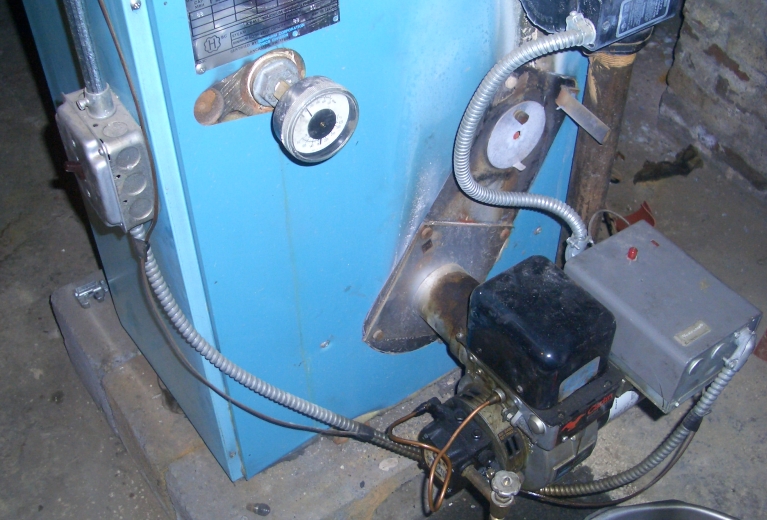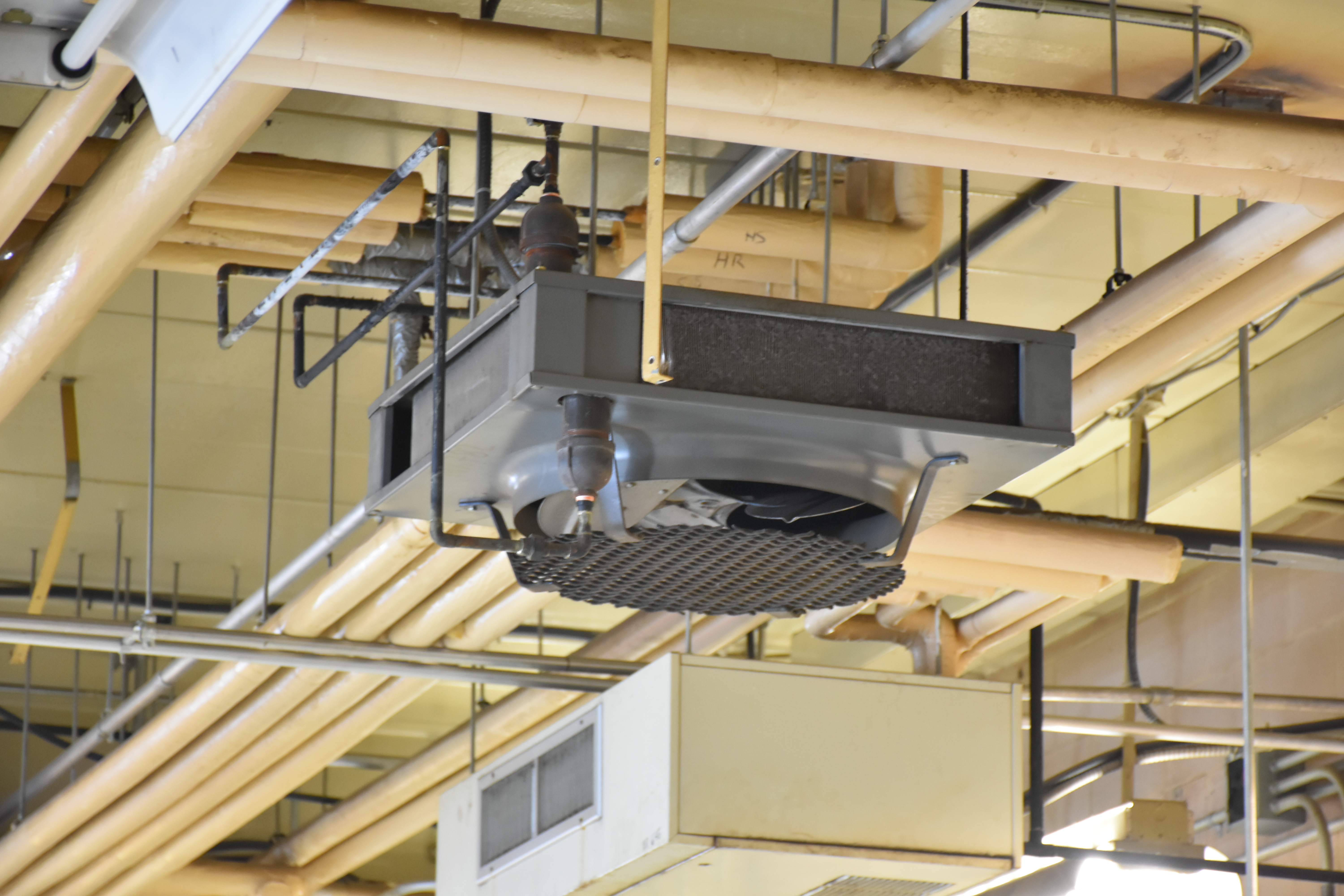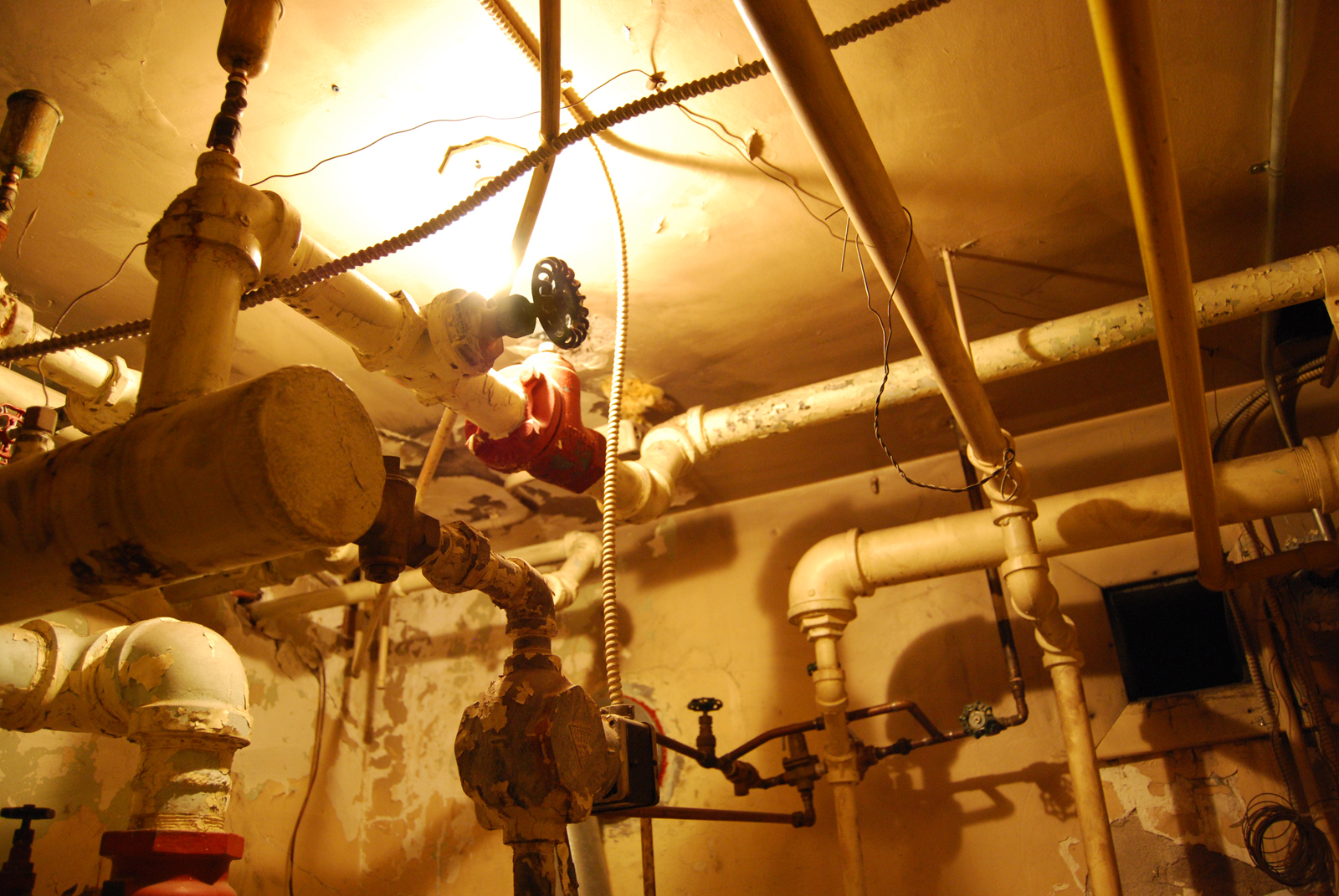|
Wood Gasification Boiler
Jetstream furnaces (later tempest wood-burning boilers), were an advanced design of wood-fired water heaters conceived by Dr. Richard Hill of the University of Maine in Orono, Maine, USA. The design heated a house to prove the theory, then, with government funding, became a commercial product. Wood-burning water furnaces, boilers and melters The furnace used a forced and induced draft fan to draw combustion air and exhaust gases through the combustion chamber at 1/3 of the speed of sound (100 m/s+). The wood was loaded into a vertical tube which passed through the water jacket into a refractory lined combustion chamber. In this chamber the burning took place and was limited to the ends of the logs. The water jacket prevented the upper parts of the logs from burning so they would gravity feed as the log was consumed. The products of combustion left the chamber and passed through a narrow ceramic neck which reached temperatures of 2000 degrees F where the gases and tars relea ... [...More Info...] [...Related Items...] OR: [Wikipedia] [Google] [Baidu] |
University Of Maine
The University of Maine (UMaine or UMO) is a Public university, public Land-grant university, land-grant research university in Orono, Maine. It was established in 1865 as the land-grant college of Maine and is the Flagship universities, flagship university of the University of Maine System. It is Carnegie Classification of Institutions of Higher Education, classified by Carnegie as among "R1: Doctoral Universities – Very high research activity". With an enrollment of approximately 11,500 students, UMaine is the state's largest college or university. The University of Maine's athletic teams, nicknamed the Maine Black Bears, Black Bears, are Maine's only NCAA Division I, Division I athletics program. Maine Black Bears men's ice hockey, Maine's men's ice hockey team has won two national championships. History The University of Maine was founded in 1862 as a function of the Morrill Land-Grant Colleges Act, Morrill Act, signed by President Abraham Lincoln. Established in 1865 as ... [...More Info...] [...Related Items...] OR: [Wikipedia] [Google] [Baidu] |
Orono, Maine
Orono () is a town in Penobscot County, Maine, United States. Located on the Penobscot and Stillwater rivers, it was first settled by American colonists in 1774. They named it in honor of Chief Joseph Orono, a sachem of the indigenous Penobscot nation who long occupied this territory. In the nineteenth century, the town became a center of the lumber industry. Sawmills on the rivers were powered by the water, and logs were floated downriver on the Penobscot for shipping and export from coastal ports. Since 1865 it has been the location of the University of Maine, established as a land-grant institution and the state's flagship educational institution. In the fall of 2018, the university enrolled 11,404 students at Orono. Not including university residents, the town's population was 11,183 at the 2020 census. Geography According to the United States Census Bureau, the town has a total area of , of which, of it is land and is water. The town is divided by the Stillwater Rive ... [...More Info...] [...Related Items...] OR: [Wikipedia] [Google] [Baidu] |
Maine
Maine () is a state in the New England and Northeastern regions of the United States. It borders New Hampshire to the west, the Gulf of Maine to the southeast, and the Canadian provinces of New Brunswick and Quebec to the northeast and northwest, respectively. The largest state by total area in New England, Maine is the 12th-smallest by area, the 9th-least populous, the 13th-least densely populated, and the most rural of the 50 U.S. states. It is also the northeasternmost among the contiguous United States, the northernmost state east of the Great Lakes, the only state whose name consists of a single syllable, and the only state to border exactly one other U.S. state. Approximately half the area of Maine lies on each side of the 45th parallel north in latitude. The most populous city in Maine is Portland, while its capital is Augusta. Maine has traditionally been known for its jagged, rocky Atlantic Ocean and bayshore coastlines; smoothly contoured mountains; heavily f ... [...More Info...] [...Related Items...] OR: [Wikipedia] [Google] [Baidu] |
Parrsboro
Parrsboro is a community located in Cumberland County, Nova Scotia, Canada. A regional service centre for southern Cumberland County, the community is also known for its port on the Minas Basin, the Ship's Company Theatre productions, and the Fundy Geological Museum. History Before the arrival of European settlers, Parrsboro was a portage point for Mikmaq travellers along the Minas Basin and Cumberland County river systems. The native inhabitants called the region "Awokum," meaning a 'short-cut' or 'passing-over point.' The first European settlers were the Acadians in 1670 at the western mouth of the Parrsboro Harbour, near Partridge Island. After they were expelled in 1755, they were replaced by New England Planters. The centre of settlement gradually shifted from Partridge Island to the sheltered estuary of the Parrsboro River where a harbour and surrounding mills grew. The settlement, at first named Mill Village, was renamed Parrsboro in honour of Nova Scotia Governor ... [...More Info...] [...Related Items...] OR: [Wikipedia] [Google] [Baidu] |
Nova Scotia
Nova Scotia ( ; ; ) is one of the thirteen provinces and territories of Canada. It is one of the three Maritime provinces and one of the four Atlantic provinces. Nova Scotia is Latin for "New Scotland". Most of the population are native English-speakers, and the province's population is 969,383 according to the 2021 Census. It is the most populous of Canada's Atlantic provinces. It is the country's second-most densely populated province and second-smallest province by area, both after Prince Edward Island. Its area of includes Cape Breton Island and 3,800 other coastal islands. The Nova Scotia peninsula is connected to the rest of North America by the Isthmus of Chignecto, on which the province's land border with New Brunswick is located. The province borders the Bay of Fundy and Gulf of Maine to the west and the Atlantic Ocean to the south and east, and is separated from Prince Edward Island and the island of Newfoundland by the Northumberland and Cabot straits, ... [...More Info...] [...Related Items...] OR: [Wikipedia] [Google] [Baidu] |
Furnace (house Heating)
A furnace (American English), referred to as a heater or boiler in British English, is an appliance used to generate heat for all or part of a building. Furnaces are mostly used as a major component of a central heating system. Furnaces are permanently installed to provide heat to an interior space through intermediary fluid movement, which may be air, steam, or hot water. Heating appliances that use steam or hot water as the fluid are normally referred to as a residential steam boilers or residential hot water boilers. The most common fuel source for modern furnaces in North America and much of Europe is natural gas; other common fuel sources include LPG (liquefied petroleum gas), fuel oil, wood and in rare cases coal. In some areas electrical resistance heating is used, especially where the cost of electricity is low or the primary purpose is for air conditioning. Modern high-efficiency furnaces can be up to 98% efficient and operate without a chimney, with a typical gas fur ... [...More Info...] [...Related Items...] OR: [Wikipedia] [Google] [Baidu] |
Hydronics
Hydronics () is the use of liquid water or gaseous water ( steam) or a water solution (usually glycol with water) as heat-transfer medium in heating and cooling systems. The name differentiates such systems from oil and refrigerant systems. Historically, in large-scale commercial buildings such as high-rise and campus facilities, a hydronic system may include both a chilled and a heated water loop, to provide for both heating and air conditioning. Chillers and cooling towers are used either separately or together as means to provide water cooling, while boilers heat water. A recent innovation is the chiller boiler system, which provides an efficient form of HVAC for homes and smaller commercial spaces. District heating Many larger cities have a district heating system that provides, through underground piping, publicly available high temperature hot water and chilled water. A building in the service district may be connected to these on payment of a service fee. Types o ... [...More Info...] [...Related Items...] OR: [Wikipedia] [Google] [Baidu] |
Gasification
Gasification is a process that converts biomass- or fossil fuel-based carbonaceous materials into gases, including as the largest fractions: nitrogen (N2), carbon monoxide (CO), hydrogen (H2), and carbon dioxide (). This is achieved by reacting the feedstock material at high temperatures (typically >700 °C), without combustion, via controlling the amount of oxygen and/or steam present in the reaction. The resulting gas mixture is called syngas (from synthesis gas) or producer gas and is itself a fuel due to the flammability of the H2 and CO of which the gas is largely composed. Power can be derived from the subsequent combustion of the resultant gas, and is considered to be a source of renewable energy if the gasified compounds were obtained from biomass feedstock. An advantage of gasification is that syngas can be more efficient than direct combustion of the original feedstock material because it can be combusted at higher temperatures so that the thermodynamic upper li ... [...More Info...] [...Related Items...] OR: [Wikipedia] [Google] [Baidu] |
Wood Gas
Wood gas is a fuel gas that can be used for furnaces, stoves, and vehicles. During the production process, biomass or related carbon-containing materials are gasified within the oxygen-limited environment of a wood gas generator to produce a combustible mixture. In some gasifiers this process is preceded by pyrolysis, where the biomass or coal is first converted to char, releasing methane and tar rich in polycyclic aromatic hydrocarbons. In stark contrast with synthesis gas, which is almost pure H2/CO mixture, wood gas ''also'' contains a variety of organic compound ("distillates") that require scrubbing for use in other applications. Depending on the kind of biomass, a variety of contaminants are produced that will condense out as the gas cools. When producer gas is used to power cars and boats or distributed to remote locations it is necessary to scrub the gas to remove the materials that can condense and clog carburetors and gas lines. Anthracite and coke are preferred for aut ... [...More Info...] [...Related Items...] OR: [Wikipedia] [Google] [Baidu] |
Wood Gas Generator
A wood gas generator is a gasification unit which converts timber or charcoal into wood gas, a producer gas consisting of atmospheric nitrogen, carbon monoxide, hydrogen, traces of methane, and other gases, which – after cooling and filtering – can then be used to power an internal combustion engine or for other purposes. Historically wood gas generators were often mounted on vehicles, but present studies and developments concentrate mostly on stationary plants. History Origins Gasification was an important and common technology during the 19th and early 20th century. Town gas produced from coal was widely used, mainly for lighting purposes. When stationary internal combustion engines based on the Otto cycle became available in the 1870s, they began displacing steam engines as prime movers in many works requiring stationary motive power. Adoption accelerated after the Otto engine's patent expired in 1886. The potential and practical applicability of gasification to int ... [...More Info...] [...Related Items...] OR: [Wikipedia] [Google] [Baidu] |
Boilers
A boiler is a closed vessel in which fluid (generally water) is heated. The fluid does not necessarily boil. The heated or vaporized fluid exits the boiler for use in various processes or heating applications, including water heating, central heating, boiler-based power generation, cooking, and sanitation. Heat sources In a fossil fuel power plant using a steam cycle for power generation, the primary heat source will be combustion of coal, oil, or natural gas. In some cases byproduct fuel such as the carbon monoxide rich offgasses of a coke battery can be burned to heat a boiler; biofuels such as bagasse, where economically available, can also be used. In a nuclear power plant, boilers called steam generators are heated by the heat produced by nuclear fission. Where a large volume of hot gas is available from some process, a heat recovery steam generator or recovery boiler can use the heat to produce steam, with little or no extra fuel consumed; such a configuration is common ... [...More Info...] [...Related Items...] OR: [Wikipedia] [Google] [Baidu] |
Plumbing
Plumbing is any system that conveys fluids for a wide range of applications. Plumbing uses pipes, valves, plumbing fixtures, tanks, and other apparatuses to convey fluids. Heating and cooling (HVAC), waste removal, and potable water delivery are among the most common uses for plumbing, but it is not limited to these applications. The word derives from the Latin for lead, ''plumbum'', as the first effective pipes used in the Roman era were lead pipes. In the developed world, plumbing infrastructure is critical to public health and sanitation. Boilermakers and pipefitters are not plumbers although they work with piping as part of their trade and their work can include some plumbing. History Plumbing originated during ancient civilizations, as they developed public baths and needed to provide potable water and wastewater removal for larger numbers of people. The Mesopotamians introduced the world to clay sewer pipes around 4000 BCE, with the earliest examples found i ... [...More Info...] [...Related Items...] OR: [Wikipedia] [Google] [Baidu] |







